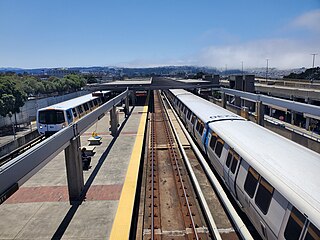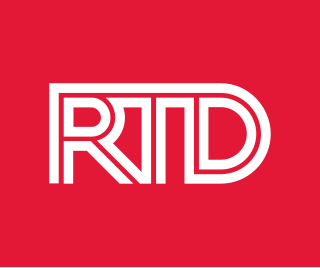
Fairbanks is a home rule city and the borough seat of the Fairbanks North Star Borough, Alaska, United States. Fairbanks is the largest city in the Interior region of Alaska and the second largest in the state. The 2020 Census put the population of the city proper at 32,515 and the population of the Fairbanks North Star Borough at 95,655, making it the second most populous metropolitan area in Alaska after Anchorage. The Metropolitan Statistical Area encompasses all of the Fairbanks North Star Borough and is the northernmost Metropolitan Statistical Area in the United States, located 196 miles by road south of the Arctic Circle.

The Maryland Transit Administration (MTA) is a state-operated mass transit administration in Maryland, and is part of the Maryland Department of Transportation. The MTA operates a comprehensive transit system throughout the Washington-Baltimore metropolitan area. There are 80 bus lines serving the Baltimore Metropolitan Area, along with rail services that include the Light Rail, Metro Subway, and MARC Train. In 2023, the system had a ridership of 52,922,000, or about per weekday as of the fourth quarter of 2023.

C-Tran, more formally the Clark County Public Transit Benefit Area Authority, is a public transit agency serving Clark County, Washington, United States, including the cities of Battle Ground, Camas, Vancouver, Washougal, and Yacolt. Founded in 1981, C-Tran operates fixed route bus services within Clark County, as well as paratransit services for qualified persons with disabilities (C-Van) and a dial-a-ride service in Camas, Ridgefield, and La Center. C-Tran also provides express commuter services between Clark County and Downtown Portland, Oregon and regional services to the Parkrose/Sumner and Delta Park MAX Light Rail stations, and Oregon Health and Science University. In 2023, the system had a ridership of 4,738,700, or about 15,900 per weekday as of the fourth quarter of 2023.

Miami-Dade Transit (MDT) is the primary public transit authority of Miami, Florida and the greater Miami-Dade County area. It is the largest transit system in Florida and the 15th-largest transit system in the United States. As of 2023, the system has 80,168,700 rides per year, or about 277,400 per weekday in the fourth quarter of 2023. MDT operates the Metrobus with their paratransit STS systems run by LSF. MDT also operates two rail transit systems: Metrorail and Metromover.
Metro Transit is the primary public transportation operator in the Minneapolis–Saint Paul area of the U.S. state of Minnesota and the largest operator in the state. Metro Transit has previously been ranked as one of the best public transit systems in the United States. In 2023, the system had a ridership of 44,977,200, or about 145,600 per weekday as of the fourth quarter of 2023.

Daly City station is an elevated Bay Area Rapid Transit (BART) station in Daly City, California, just south of the city limits of San Francisco. It is adjacent to Interstate 280 and California Route 1, which it serves as a park-and-ride station. The station is served by the Red, Yellow, Green, and Blue lines; it is the west terminal for the Green and Blue lines.

ABQ RIDE is the local transit agency serving Albuquerque, New Mexico. ABQ RIDE operates a variety of city bus routes including two Albuquerque Rapid Transit (ART) bus rapid transit lines and a currently suspended ARTx express bus line It is the largest public transportation system in the state, serving 6,907,500 passengers in 2023, or about 21,100 per weekday as of the fourth quarter of 2023.

The Regional Transportation District, more commonly referred to as RTD, is the regional agency operating public transit services in eight out of the twelve counties in the Denver-Aurora-Boulder Combined Statistical Area in the U.S. state of Colorado. It operates over a 2,342-square-mile (6,070 km2) area, serving 3.08 million people. RTD was organized in 1969 and is governed by a 15-member, publicly elected Board of Directors. Directors are elected to a four-year term and represent a specific district of about 180,000 constituents.

People in the San Francisco Bay Area rely on a complex multimodal transportation infrastructure consisting of roads, bridges, highways, rail, tunnels, airports, seaports, and bike and pedestrian paths. The development, maintenance, and operation of these different modes of transportation are overseen by various agencies, including the California Department of Transportation (Caltrans), the Association of Bay Area Governments, San Francisco Municipal Transportation Agency, and the Metropolitan Transportation Commission. These and other organizations collectively manage several interstate highways and state routes, eight passenger rail networks, eight trans-bay bridges, transbay ferry service, local and transbay bus service, three international airports, and an extensive network of roads, tunnels, and bike paths.

The Capital Area Transportation Authority (CATA) is the public transit operator serving the Lansing, Michigan area, including service on the campus of Michigan State University. In 2023, the system had a ridership of 8,082,200.
The Capital Metropolitan Transportation Authority, officially stylized as CapMetro, is a public transportation provider located in Austin, Texas. It operates bus, paratransit services and a hybrid rail system known as CapMetro Rail in Austin and several suburbs in Travis and Williamson counties. In 2023, the system had a ridership of 25,229,400, or about 81,500 per weekday as of the fourth quarter of 2023.

Tucson Transit Management LLC, doing business as Sun Tran, is the public transit system serving the city of Tucson, Arizona. In 2023, the system had 17,361,800 rides, or about 60,400 per weekday as of the fourth quarter of 2023. 100% of the fleet utilizes clean-burning fuels, such as compressed natural gas (CNG), biodiesel, and hybrid technologies. In addition to more than 40 bus routes, the system also includes the Sun Link modern streetcar line.
The North County Transit District is the agency responsible for public transportation in Northern San Diego County, California. The agency manages the COASTER commuter rail service between Oceanside and San Diego, the SPRINTER hybrid rail service between Escondido and Oceanside, the BREEZE transit bus service, LIFT paratransit service, and FLEX on-demand and point-deviation service.

San Joaquin Regional Transit District is a transit district that provides bus service to the city of Stockton, California and the surrounding communities of Lodi, Ripon, Thornton, French Camp, Lathrop, Manteca, and Tracy. In 2023, the system had a ridership of 2,432,000, or about 9,100 per weekday as of the fourth quarter of 2023.

The following is a list of transportation options in San Diego County, California.
CamTran, originally called the Cambria County Transit Authority operates mass transit bus service within Johnstown, Pennsylvania, Cambria County, and Windber, Pennsylvania, Somerset County, Pennsylvania. CamTran also operates the Johnstown Inclined Plane, which they took over in 1983 from Westmont, Pennsylvania borough. The transit system began operation in 1976, from the remnants of the Johnstown Traction Company. While the Cambria County Transit Authority (CCTA) began operation on July 20, 1976, service did not begin until December 1, 1976. In June 1999, CCTA became CamTran. In 2023, the system had a ridership of 752,700, or about 2,100 per weekday as of the fourth quarter of 2023.

The following outline is provided as an overview of and topical guide to the U.S. state of Alaska:

The Monroe County Transit Authority (MCTA), also known as the Pocono Pony, is a public transportation service located in Monroe County, Pennsylvania. It provides rural and inter-city fixed route bus and paratransit service within the county. MCTA is funded in part by PennDOT, the Federal Transit Administration, local match and farebox revenue.
Green Mountain Community Network (GMCN) is a private, nonprofit organization, that owns and operates the public transit system by local bus in Bennington County in southwestern Vermont called the Green Mountain Express. Their bus service currently has 3 local "fixed deviated" weekday routes in Bennington: the Red, Blue and Brown routes, which can deviate up to 1/4 mile from their alignment upon request. They also have two local Saturday routes, and three commuter routes: the Orange Line, with weekday plus Saturday service to Manchester; the Purple Line, with weekday service to Williamstown, Massachusetts; and the Emerald line, with weekday service to Wilmington. The Emerald Line is a partnership between West Dover-based Southeast Vermont Transit's "the MOOver" and GMCN.

Green Mountain Transit (GMT) is the regional public transit system based in Burlington, Vermont, which was formed in 2016 through the merger of two more localized transit systems: the Chittenden County Transportation Authority and the Green Mountain Transit Authority. In 2023, the system had a ridership of 1,774,100, or about 7,300 per weekday as of the fourth quarter of 2023.

















